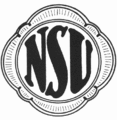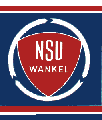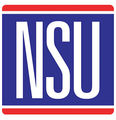.
NSU: Difference between revisions
Red marquis (talk | contribs) |
Red marquis (talk | contribs) mNo edit summary |
||
| (9 intermediate revisions by 2 users not shown) | |||
| Line 1: | Line 1: | ||
{{List of {{PAGENAME}} Models}}'''NSU Motorenwerke | {{List of {{PAGENAME}} Models}} | ||
'''NSU Motorenwerke AG''' (normally just '''NSU''') was a German manufacturer of [[automobile|cars]] and motorcycles and a predecessor to what is now [[Audi]]. | |||
==History== | ==History== | ||
NSU began as a knitting machine manufacturer | NSU began as a knitting machine manufacturer in the town of Riedlingen on the Danube in 1873, and moved to Neckarsulm, where the river Sulm flows into the river Neckar, in 1884. In 1886 the company began to produce bicycles, the first of them branded as the "Germania", and by 1892, bicycle manufacturing had completely replaced the knitting machine production. At about this time, the name NSU (from Neckar and Sulm) appeared as brand name. | ||
The first NSU motorcycle appeared in 1901,<ref>{{cite web|url=http://www.motorcycleclassics.com/motorcycle-reviews/1956-nsu-supermax.aspx|title=1956 NSU Supermax|publisher=Motorcycle Classics|accessdate=2009-08-24|date=Premier Issue|author=Ric Anderson}}</ref> followed by the first NSU car in 1905. In 1932 the car production in Heilbronn was sold to [[Fiat]]. | |||
In 1932 the car production in Heilbronn was sold to [[Fiat]]. | |||
During World War II NSU designed and produced the famous | During World War II NSU designed and produced the famous Kettenkrad, the NSU HK101, a [[half-track]]ed motorcycle with the engine of the [[Opel]] Olympia. | ||
In December 1946 [[Auto, Motor und Sport|Das Auto]] reported the the company had resumed the manufacture of bicycles and motor-bicycles at Neckarsulm.<ref name=DasAuto01>{{cite journal| authorlink = F A L Martin (Ed)| title =Aktuelles aus aller Welt| journal = [[Auto, Motor und Sport|Auto Motor u. Sport]]| volume = Heft 13 1996| pages = Seite 23|date = date December 1946}}</ref> For Germany this was a time of new beginnings: in July 1946, a new board had been appointed, headed up by General Director Walter Egon Niegtsch, who earlier in his career had spent 17 years with [[Opel]].<ref name=DasAuto01/> | |||
NSU motorbike production restarted, in a completely destroyed plant, with pre-war designs like the Quick, OSL and Konsul motorbikes; furthermore, the HK101 continued to be sold by NSU as an all-terrain vehicle in a civil version. The first post-war construction was the NSU Fox in 1949, available in a 2-stroke and a 4-stroke version. In 1953 the famous NSU Max followed, a 250 cc motorbike with a unique overhead camdrive with connecting rods. All these new models had a very innovative monocoque frame of pressed steel and a central rear suspension unit. [[Albert Roder]], the genius chief engineer behind the success story, made it possible that in 1955 NSU became the biggest motorcycle producer in the world. NSU also holds 4 world records for speed: 1951, 1953, 1954, and 1955. In August 1956 Wilhelm Herz at the Bonneville Salt Flats, Utah, became the first man to ride a motorcycle faster than 200 mph (322 km/h). | |||
In | |||
In 1957 NSU re-entered the car market with the new [[NSU Prinz|Prinz]] (Prince), a small car with a doubled NSU Max engine, an [[aircooling|air cooled]] two-cylinder engine of 600 cc (37 cu in) and 20 hp (15 kW). Motorbike production continued until 1968. NSU's last production motorcycle was the Quick 50.<ref name=SparesGallery>[http://www.nsuquicklyspares.co.uk/gallery.html NSU Quickly Spares Gallery]</ref><ref name=FredyQ50>[http://www.nsu-cars.ch/Quick50.htm Fredy's NSU Page:Quick 50]</ref> | |||
In 1964 NSU offered the world's first [[Wankel engine]]d car: the Wankelspider. In development of the project, NSU built the '''Sport Prinz''', with a 129 hp (96 kW) 995 cc (60.7 cu in) 2-rotor.<ref>Lyons, Pete. "10 Best Ahead-of-Their-Time Machines", in ''Car and Driver'', 1/88, p.78.</ref> In the same year Prinz 1000 and derivatives like the TT and TT/S followed. As a family car the Typ 110 (later called 1200SC) was launched in 1965 with a more spacious body design. The last NSU cars with a conventional four-stroke engine had the air cooled [[OHC]] four cylinder engine in common. | |||
NSU | In 1967, the sensational four-door [[NSU Ro 80]], with a 115 hp (86 kW) version of the same 2-rotor,<ref name="Lyons, p.78">Lyons, p.78.</ref> was presented to public. Weighing 2,600 lb (1,200 kg), it had C<sub>d</sub> of 0.36, [[disc brake]]s, [[independent suspension]], and front wheels drive by [[ZF Sachs|Fichtel & Sachs]] ''Saxomatic'' three-speed [[transmission]].<ref name="Lyons, p.78"/> It soon gained several design awards like "car of the year 1967", while drivers liked its performance.<ref name="Lyons, p.78"/> Virtually all the world's major motor manufacturers purchased from NSU licenses to develop and produce the rotary engine, with the single notable exception of [[BMW]].<ref name=AutoMotoruSport19961303>{{cite journal| authorlink = Gert Hack (Bernd Ostmann - Ed)| title =In voller Blüte. In den sechziger Jahren...| journal = [[Auto, Motor und Sport|Auto Motor u. Sport]]| volume = Heft 13 1996| pages = Seite 76-83|date = date 14 June 1996}}</ref> | ||
Only [[Mazda]] continued | Despite its public acclaim, sales of the Ro 80 were disappointing. The transmission drew complaints and the engine suffered numerous failures even at low mileage.<ref name="Lyons, p.78"/> Competitor auto-makers, apart from [[Mazda]], now held back from taking a lead in developing and marketing the Wankel technology, and anticipated income associated with those royalty deals failed to materialize. | ||
===Volkswagen Group takeover=== | |||
The development of the rotary engine was very cost-intensive for the small company. Problems with the tip seals of the engine rotor significantly damaged the brand's reputation amongst consumers. In 1969, the company was taken over by [[Volkswagen Group]], who merged NSU with [[Auto Union]]. The new, merged, company was called ''[[Audi]] NSU [[Auto-Union]] A.G'' and represented the effective end of both the NSU and [[DKW]] marques with all future production to bear the Audi badge (although retaining the four interlocking circles of Auto Union). The management of the Neckarsulm plant moved to Audi's headquarters in Ingolstadt. Since the small rear engined NSU models (Prinz 4, 1000, 1200) phased out in 1973, the Ro 80 was the last car still in production carrying the NSU badge. Audi never made use of the brand name NSU again after April 1977, when the last Ro 80 was sold.<ref name="Lyons, p.78"/> | |||
Even as production of the Ro 80 continued in the Neckarsulm plant, production of larger Audi models like [[Audi 100|100]] and [[Audi 200|200]] was started. The [[Porsche 924]] and later [[Porsche 944]] were also assembled in the Neckarsulm plant. Those models were joint venture projects of [[Porsche]] and [[VW]], but Porsche did not have the internal capacity to build the 924 and 944. In the present day, Neckarsulm is the production plant for Audi's topline vehicles like [[Audi A6|A6]], [[Audi A8|A8]] and [[Audi R8 (road car)|R8]]. Furthermore, it is the home of the "Aluminium- und Leichtbauzentrum" where Audi's aluminium-made space frame bodies are designed and engineered. | |||
NSU is primarily remembered today as the first licensee and one of only three automobile companies to produce cars for sale with rotary [[Wankel engine]]s. NSU invented the principle of the modern Wankel engine with an inner rotor. The [[NSU Ro 80]] was the second mass-produced two-rotor Wankel-powered vehicle after the [[Mazda Cosmo]]. In 1967, NSU and [[Citroën]] set up a common company, [[Comotor]], to build engines for [[Citroën]] and other car makers. Only [[Mazda]] continued developing the Wankel engine. Mazda currently has a reliable sportscar, the RX-8, in its portfolio looking back on a successful [[Mazda Wankel engine|Wankel engine family]]. | |||
A museum in Neckarsulm, the Deutsches Zweirad- und NSU-Museum, has many of NSU's products on display. | |||
==NSU products== | ==NSU products== | ||
| Line 40: | Line 47: | ||
==Photos== | |||
<gallery> | |||
Image:Nsu logo 18821.jpg|1882 logo | |||
Image:Nsu logo 1913.gif|1913 logo | |||
Image:Nsu logo 1935.gif|1935 logo | |||
Image:Nsu logo 1958.jpg|1958 logo | |||
Image:Nsu logo 1960.gif|1960 Wankel logo | |||
Image:Nsu logo.jpg | |||
</gallery> | |||
==See also== | ==See also== | ||
| Line 55: | Line 69: | ||
[[Category:NSU|*]] | [[Category:NSU|*]] | ||
[[Category:Makes]] | [[Category:Makes]] | ||
[[Category:Defunct motor vehicle manufacturers of Germany]] | |||
Latest revision as of 10:17, 20 September 2010
Search By ModelError creating thumbnail: Unable to save thumbnail to destination
|
| Defunct |
NSU Motorenwerke AG (normally just NSU) was a German manufacturer of cars and motorcycles and a predecessor to what is now Audi.
History
NSU began as a knitting machine manufacturer in the town of Riedlingen on the Danube in 1873, and moved to Neckarsulm, where the river Sulm flows into the river Neckar, in 1884. In 1886 the company began to produce bicycles, the first of them branded as the "Germania", and by 1892, bicycle manufacturing had completely replaced the knitting machine production. At about this time, the name NSU (from Neckar and Sulm) appeared as brand name.
The first NSU motorcycle appeared in 1901,<ref>Template:Citation/core{{#if:|}}</ref> followed by the first NSU car in 1905. In 1932 the car production in Heilbronn was sold to Fiat.
During World War II NSU designed and produced the famous Kettenkrad, the NSU HK101, a half-tracked motorcycle with the engine of the Opel Olympia.
In December 1946 Das Auto reported the the company had resumed the manufacture of bicycles and motor-bicycles at Neckarsulm.<ref name=DasAuto01>{{#if:
|{{#if:F A L Martin (Ed)
|{{#if:
|{{{last}}}{{#if:
|, {{{first}}}
}}
|{{{author}}}
}}
|{{#if:
|{{{last}}}{{#if:
|, {{{first}}}
}}
|{{{author}}}
}}
}}
}}{{#if:
|{{#if:
|, {{{coauthors}}}
}}
}}{{#if:date December 1946
| (date December 1946)
|{{#if:
|{{#if:
| ({{{month}}} {{{year}}})
| ({{{year}}})
}}
}}
}}{{#if:
|.
}}{{#if:
|[{{{url}}}
|
}} {{#if: |“|"}}Aktuelles aus aller Welt{{#if: |”|"}}{{#if:
|] |
}}{{#if:
| ({{{format}}})
}}{{#if:Auto Motor u. Sport
|. Auto Motor u. Sport
}}{{#if:Heft 13 1996
| Heft 13 1996
}}{{#if:
| ({{{issue}}})
}}{{#if:Seite 23
|: Seite 23
}}{{#if:
| . DOI:{{{doi}}}
}}{{#if:
|. {{{id}}}
}}{{#if:
|. Retrieved on [[{{{accessdate}}}]]
}}.</ref> For Germany this was a time of new beginnings: in July 1946, a new board had been appointed, headed up by General Director Walter Egon Niegtsch, who earlier in his career had spent 17 years with Opel.<ref name=DasAuto01/>
NSU motorbike production restarted, in a completely destroyed plant, with pre-war designs like the Quick, OSL and Konsul motorbikes; furthermore, the HK101 continued to be sold by NSU as an all-terrain vehicle in a civil version. The first post-war construction was the NSU Fox in 1949, available in a 2-stroke and a 4-stroke version. In 1953 the famous NSU Max followed, a 250 cc motorbike with a unique overhead camdrive with connecting rods. All these new models had a very innovative monocoque frame of pressed steel and a central rear suspension unit. Albert Roder, the genius chief engineer behind the success story, made it possible that in 1955 NSU became the biggest motorcycle producer in the world. NSU also holds 4 world records for speed: 1951, 1953, 1954, and 1955. In August 1956 Wilhelm Herz at the Bonneville Salt Flats, Utah, became the first man to ride a motorcycle faster than 200 mph (322 km/h).
In 1957 NSU re-entered the car market with the new Prinz (Prince), a small car with a doubled NSU Max engine, an air cooled two-cylinder engine of 600 cc (37 cu in) and 20 hp (15 kW). Motorbike production continued until 1968. NSU's last production motorcycle was the Quick 50.<ref name=SparesGallery>NSU Quickly Spares Gallery</ref><ref name=FredyQ50>Fredy's NSU Page:Quick 50</ref>
In 1964 NSU offered the world's first Wankel engined car: the Wankelspider. In development of the project, NSU built the Sport Prinz, with a 129 hp (96 kW) 995 cc (60.7 cu in) 2-rotor.<ref>Lyons, Pete. "10 Best Ahead-of-Their-Time Machines", in Car and Driver, 1/88, p.78.</ref> In the same year Prinz 1000 and derivatives like the TT and TT/S followed. As a family car the Typ 110 (later called 1200SC) was launched in 1965 with a more spacious body design. The last NSU cars with a conventional four-stroke engine had the air cooled OHC four cylinder engine in common.
In 1967, the sensational four-door NSU Ro 80, with a 115 hp (86 kW) version of the same 2-rotor,<ref name="Lyons, p.78">Lyons, p.78.</ref> was presented to public. Weighing 2,600 lb (1,200 kg), it had Cd of 0.36, disc brakes, independent suspension, and front wheels drive by Fichtel & Sachs Saxomatic three-speed transmission.<ref name="Lyons, p.78"/> It soon gained several design awards like "car of the year 1967", while drivers liked its performance.<ref name="Lyons, p.78"/> Virtually all the world's major motor manufacturers purchased from NSU licenses to develop and produce the rotary engine, with the single notable exception of BMW.<ref name=AutoMotoruSport19961303>{{#if:
|{{#if:Gert Hack (Bernd Ostmann - Ed)
|{{#if:
|{{{last}}}{{#if:
|, {{{first}}}
}}
|{{{author}}}
}}
|{{#if:
|{{{last}}}{{#if:
|, {{{first}}}
}}
|{{{author}}}
}}
}}
}}{{#if:
|{{#if:
|, {{{coauthors}}}
}}
}}{{#if:date 14 June 1996
| (date 14 June 1996)
|{{#if:
|{{#if:
| ({{{month}}} {{{year}}})
| ({{{year}}})
}}
}}
}}{{#if:
|.
}}{{#if:
|[{{{url}}}
|
}} {{#if: |“|"}}In voller Blüte. In den sechziger Jahren...{{#if: |”|"}}{{#if:
|] |
}}{{#if:
| ({{{format}}})
}}{{#if:Auto Motor u. Sport
|. Auto Motor u. Sport
}}{{#if:Heft 13 1996
| Heft 13 1996
}}{{#if:
| ({{{issue}}})
}}{{#if:Seite 76-83
|: Seite 76-83
}}{{#if:
| . DOI:{{{doi}}}
}}{{#if:
|. {{{id}}}
}}{{#if:
|. Retrieved on [[{{{accessdate}}}]]
}}.</ref>
Despite its public acclaim, sales of the Ro 80 were disappointing. The transmission drew complaints and the engine suffered numerous failures even at low mileage.<ref name="Lyons, p.78"/> Competitor auto-makers, apart from Mazda, now held back from taking a lead in developing and marketing the Wankel technology, and anticipated income associated with those royalty deals failed to materialize.
Volkswagen Group takeover
The development of the rotary engine was very cost-intensive for the small company. Problems with the tip seals of the engine rotor significantly damaged the brand's reputation amongst consumers. In 1969, the company was taken over by Volkswagen Group, who merged NSU with Auto Union. The new, merged, company was called Audi NSU Auto-Union A.G and represented the effective end of both the NSU and DKW marques with all future production to bear the Audi badge (although retaining the four interlocking circles of Auto Union). The management of the Neckarsulm plant moved to Audi's headquarters in Ingolstadt. Since the small rear engined NSU models (Prinz 4, 1000, 1200) phased out in 1973, the Ro 80 was the last car still in production carrying the NSU badge. Audi never made use of the brand name NSU again after April 1977, when the last Ro 80 was sold.<ref name="Lyons, p.78"/>
Even as production of the Ro 80 continued in the Neckarsulm plant, production of larger Audi models like 100 and 200 was started. The Porsche 924 and later Porsche 944 were also assembled in the Neckarsulm plant. Those models were joint venture projects of Porsche and VW, but Porsche did not have the internal capacity to build the 924 and 944. In the present day, Neckarsulm is the production plant for Audi's topline vehicles like A6, A8 and R8. Furthermore, it is the home of the "Aluminium- und Leichtbauzentrum" where Audi's aluminium-made space frame bodies are designed and engineered.
NSU is primarily remembered today as the first licensee and one of only three automobile companies to produce cars for sale with rotary Wankel engines. NSU invented the principle of the modern Wankel engine with an inner rotor. The NSU Ro 80 was the second mass-produced two-rotor Wankel-powered vehicle after the Mazda Cosmo. In 1967, NSU and Citroën set up a common company, Comotor, to build engines for Citroën and other car makers. Only Mazda continued developing the Wankel engine. Mazda currently has a reliable sportscar, the RX-8, in its portfolio looking back on a successful Wankel engine family.
A museum in Neckarsulm, the Deutsches Zweirad- und NSU-Museum, has many of NSU's products on display.
NSU products
Cars
NSU produced the following post - war cars:
- NSU Prinz I, II, 30 and III (1957-1962)
- NSU Sport Prinz (1959-1967)
- NSU Prinz 4, 4L (1961-1972)
- NSU Prinz 1000, NSU 1000 (1964-1972)
- NSU 1000 TT, NSU TT, NSU TTS (1965-1972)
- NSU Typ 110, NSU 1200 (1965-1972)
- NSU Spider (1964-1967)
- NSU Ro 80 (1967-1977)
- NSU K70, produced after VW/Audi takeover as the VW K70 (1970-1975)
Photos
See also
| image (between 170-190 pixels) | ||
| NSU | ||
|
Volkswagen | Audi | SEAT | Škoda | Bentley | Bugatti | Lamborghini | Porsche Historic Prinz · Sport Prinz · Prinz 4 · Prinz 1000 · 1000 TT · Typ 110 · Spider · Ro 80 · K70 Include notable internal links here | ||
| name of founder/s | defunct | |





